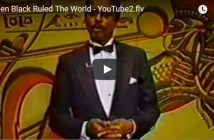originally posted on AtlantaBlackStar.com


Although the great majority of the people of the Philippines today are Tagalog, the country is not racially monolithic. In spite of their small numbers today the original inhabitants of the Philippines are the Diminutive Africoids, who still live in scattered communities in the Phillipines and are commonly and pejoratively called Pygmies, Negritos, Aeta, and a variety of other names based upon their specific locale. The word Aeta, a widely-used Tagalog term meaning filthy, is especially derogatory.
At least one group of Diminutive Africoids in the Philippines is known as the Agta (the People). I am, however, reluctant to the use the term Agta as a blanket term for the entire population of Diminutive Africoids in the Philippines, for fear of lumping groups together with a broadly similar phenotypes but not necessarily cultural similarities. Such an approach would only tend to perpetuate an injustice to an already wounded sense of humanity to a once proud people. In regard to phenotype, broadly speaking, these Black people can be described as short in stature, dark-skinned, spiral-haired and broad-nosed. They are an extremely ancient people and are no doubt modern representatives of the world’s earliest-known modern humans.
In stark contrast to the Diminutive Africoids, the Tagalog majority seem to have only entered the Philippines during the last several thousand years, and while not enough is known of the early history of the Diminutive Africoids in the Philippines, it has been well-documented that they engaged in bitter martial conflicts with the Spanish invaders, whose presence in the islands began in the 16th century. It was the Spaniards who named the aboriginal people of the Philippines Negritos, meaning little Blacks.
These are the Diminutive Africoids—the first people of the Phillipines. Once a proud people, today, they are generally despised by their Tagalog countrymen. They were, however, at one time, for thousands of years, the masters of the land.


Collectively, the story of the first people of the Philippines—the Diminutive Africoids–is truly fascinating. Individually, the story of David Fagen, an African-American soldier in the U.S. Army stationed in the Philippines during the Philippine Insurrection (1899-1901) and who defected to the Filipino freedom fighters, is remarkable, especially in its symbolism.
In November 1899, when he was in his early 20s, U.S. Army Corporal David Fagen defected from the 24th Infantry Regiment and went over the revolutionary insurrectionist forces led by Emilio Aguinaldo. Working with the insurrectionist army, Fagen quickly distinguished himself as a guerrilla fighter against his former comrades and fought so effectively that he was referred to as “General Fagen” by his Filipino companions. Indeed, as his exploits became so widely known he was actually referred to as “General Fagen” in the New York Times. Officially, he was quickly promoted by the guerrillas from first lieutenant to captain. From August 1900 to January 1901 he was in involved in at least eight clashes with U.S. forces.

As pressure was brought to bear on the insurrectionist forces and the major rebel leaders dead or captured, Fagen’s position became more and more tenuous. Indeed, the U.S. Army became obsessed with his capture and put a substantial bounty on his head.
Fagen’s end is not clear. One account has him assassinated and decapitated. Another has him living long and peacefully in the mountains of the Philippines, within a supportive and embracing Diminutive Africoid community. The latter account is very pleasing to me.
*Runoko Rashidi is a historian, writer, lecturer and researcher based in Los Angeles, California. He has written extensively on the Global African Presence and leads tours to various sites around the world. This essay is culled from his most recent work African Star over Asia: The Black Presence in the East, published by Books of Africa in 2012. His upcoming tours include the African heritage in Mexico in July 2014, the African heritage in Europe in August 2014 and Nigeria and Cameroon in December 2014. For more information write to Runoko@hotmail.com or go to www.travelwithrunoko.com






